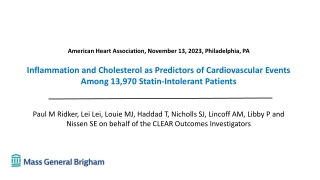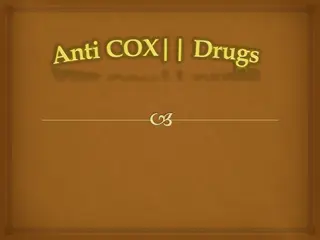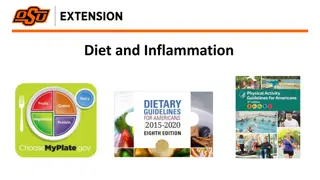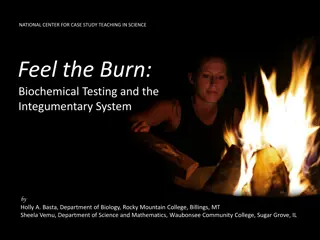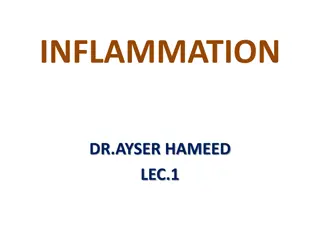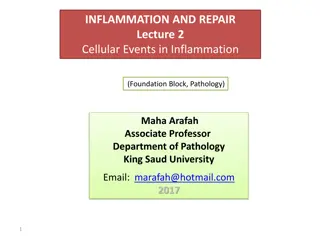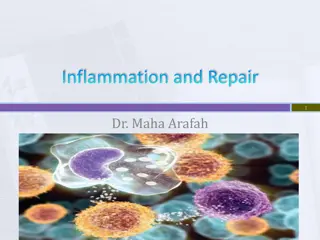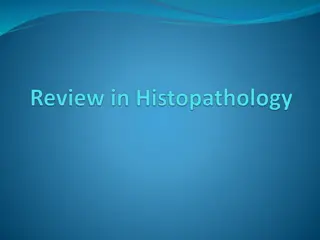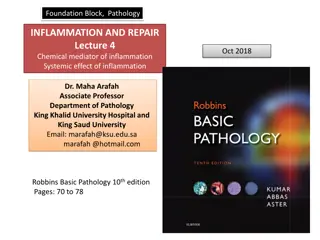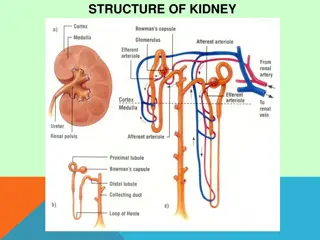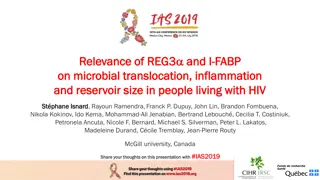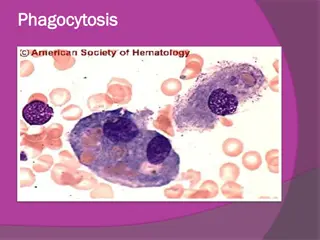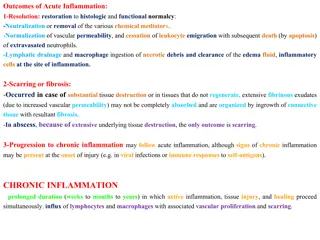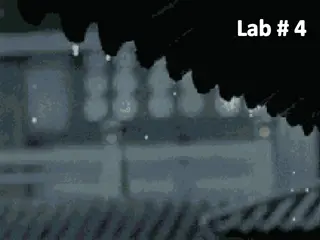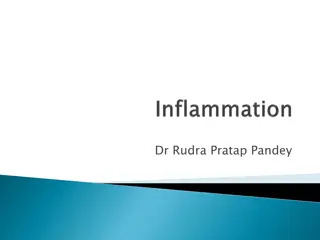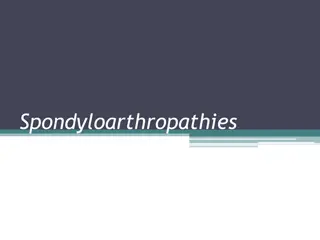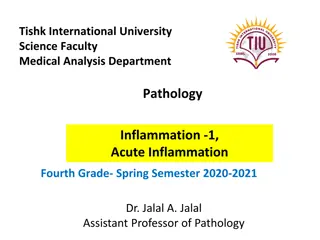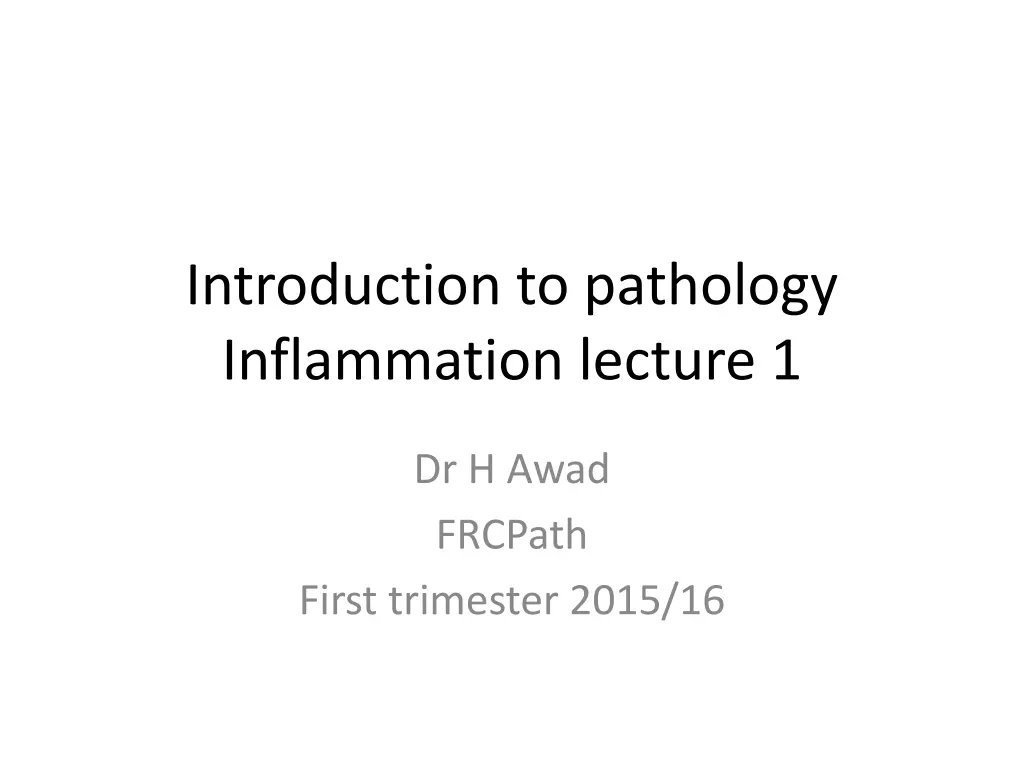
Understanding Inflammation: Definition, Signs, Causes, and Differences
Explore the fundamental aspects of inflammation, including its definition, signs, causes, and differences such as infection versus inflammation and acute versus chronic inflammation. Gain insights into the protective response involving host cells, blood vessels, and chemical mediators, intended to eliminate the initial cause of injury and initiate repair processes.
Uploaded on | 0 Views
Download Presentation

Please find below an Image/Link to download the presentation.
The content on the website is provided AS IS for your information and personal use only. It may not be sold, licensed, or shared on other websites without obtaining consent from the author. If you encounter any issues during the download, it is possible that the publisher has removed the file from their server.
You are allowed to download the files provided on this website for personal or commercial use, subject to the condition that they are used lawfully. All files are the property of their respective owners.
The content on the website is provided AS IS for your information and personal use only. It may not be sold, licensed, or shared on other websites without obtaining consent from the author.
E N D
Presentation Transcript
Introduction to pathology Inflammation lecture 1 Dr H Awad FRCPath First trimester 2015/16
Inflammation Definition Protective response involving (1)host cells, (2)blood vessels and (3)chemical mediators , intended to (1)eliminate (a)the initial cause of injury and the (b)necrotic tissue resulting from the insult (2)initiate repair.
Unintended outcomes! Inflammation is a protective mechanism .. Not a disease However cells and mediators that destroy injurious agents can destroy normal tissue.
Signs of inflammation Calor . hotness Rubor .. redness Tumor .. swelling Dolor pain Functio laesa.. Loss of function
Causes of inflammation any cause of cell injury Infections Trauma Physical : thermal injury, burns Chemicals Tissue necrosis: ischemia or physical insult Foreign bodies Immune reaction
Infection versus inflammation What are the differences????
Acute versus chronic Acute: rapid onset, short duration, fluid and plasma protein exudation, predominantly neutrophils. Chronic: insidious onset, longer duration ( days to years), lymphocytes and macrophages, vascular proliferation and fibrosis.
Acute versus chronic inflammation feature acute chronic onset Fast: Minutes to hours Slow: days cells neutrophils Lymphocytes & macrophages Tissue injury and fibrosis Mild and self limited Severe, progressive Local and systemic signs prominent May be subtle
mechanisms So.. Cells and molecules needed for the inflammatory response. These are present in the blood. The goal of the inflammatory reaction is to bring these cells and mediators to the site of injury.
Chemical mediators Secreted from inflammatory and host cells (e:g cytokines) Derived from plasma proteins (complement)
Self control Inflammation is controlled and self limited. Inflammatory cells are short lived, and degraded or become inactive. Anti inflammatory mediators.
Recognition of injurious agent Receptors on several cells recognize injurious agents. These receptors present on macrophages, dendritic cells , epithelial cells and others. These receptors are called pattern recognition receptors because they recognize structures common to many microbes or dead cells.
Pattern recognition receptors Two families: Toll like receptors. inflammasomes
Toll like receptors Microbial sensors. 10 mammalian types: Can recognize bacterial products : endotoxins or DNA. Can recognize viral products: RNA
Toll like receptors Located on plasma membrane and endosomes. So: can recognize extracellular and ingested microbes.
Toll like receptors Once they recognize the microbe transcription factors activation which stimulate production of chemical agents (inflammatory mediators)
Inflammasome Multi-protein cytoplasmic complex. Recognizes products of dead cells uric acid, extracellular ATP, crystals, some microbes.. When stimulated, inflammasome activates caspase 1. Caspase 1.. Cleaves and thus activates IL- 1 which is a potent mediator.
Inflammasome in action 1)Gout Urate crystals deposited in joints.. Ingested by macrophages.. Activate inflammasome IL 1 production inflammation 2)Inflammasome stimulated by cholesterol crystals.. Possible role of inflammasome in atherosclerosis. 3) Also activated by free fatty acids in obese people development of type 2 DM. ???TREATMENT BY blocking IL 1
Acute inflammation Vascular changes: *vasodilation and increased vascular permeability. *endothelial cell activation to increase leukocyte adhesion and migration . Cellular events:
Vascular changes 1)Transient vasoconstriction.. Seconds. 2)Vasodilation increased blood flow. 3) Increased vascular permeability extravascular edema 4) loss of fluids from capillaries increases blood viscosity slowing of circulation = stasis 5) stasis.. Neutrophils accumulate at the epithelial side = margination (the first step in leukocyte activation)
Increased vascular permeability Results in edema. Edema caused by inflammation is usually an exudate Transudate versus exudate???
exudate Edema fluid caused usually by inflammation. Fluid rich in protein, cell debris and leukocytes. High specific gravity Transudate low protein, low cell debris, no cells . Due to changes in hydrostatic or osmotic pressure .. Here only fluid is lost
Causes of increased vascular permeability in inflammation Endothelial cell contraction.. Increasing the gaps through which fluid is lost Endothelial injury.. Loss of the barrier that prevents fluid to go out of the vessels. Increased transocytosis Leakage from new blood vessels.
Endothelial cell contraction Most common cause of increased permeability. Rapid response due to histamine, bradykinin and leukotrienes. Short lived. A similar response occurs due to cytokines.. Changes to cytoskeleton increasing the gaps.. This is slower but more prolonged.
Endothelial injury Damage due to severe injury.. E:g burns or infections. Can start immediately but lasts for several hours or days till the vessel is thrombosed If injury is mild effect (permeability increase) can be delayed but long lived. E:g in mild thermal injury or certain bacterial toxins
neovascularization New blood vessels formed during repair. Leaky till proliferation of endothelial cells matures adequately to form intracellular junctions.

